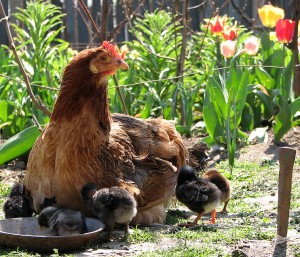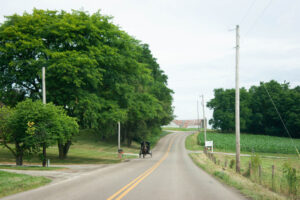Greetings from “Land’s End ” in Nova Scotia
 Bugs, the nemesis of all gardeners, are especially persistent in our organic garden this year and in the hot house. Bill has never used anything but organic natural methods in gardening here for twenty-three years.
Bugs, the nemesis of all gardeners, are especially persistent in our organic garden this year and in the hot house. Bill has never used anything but organic natural methods in gardening here for twenty-three years.
It took three years , after planting our first garden , to have a decent harvest. The farm was run out and neglected for about thirty years before we bought it. The land was full of wire worms, thistles, wild bamboo, wood ticks and dead grass. Bugs and weeds have been a very real challenge. They were thriving together before we took over this farm.
Those first years our potatoes were full of wire worms. Wire worms are often found in old sod ground that hasn’t been tilled for a long time. Over the space of several years my husband studied the life cycle of the wire worm. He discovered by digging the potatoes earlier than usual he could interfere with the life cycle of the little critters. They were disturbed before they got into the potatoes or had time to reproduce. Eventually the wire worms were gone from that one field. Digging potatoes early meant smaller ones but at least they were free of wire worms.
Bill rotates crops so when it came time to plant potatoes in a different place the same problem appeared again It was dealt with in the same way. Over the coarse of several rotations the wire worms have been less of a problem as all our garden areas have been used at some point. We only occasionally break up sod ground now.
Then there are those pesky potato bugs! They multiply worse than rabbits! This year particularly they have been bad. When the kids [ of human kind ] were young we use to pay them a penny for each five potato bugs they collected in their glass jars. Once they learned there was easier ways to earn money we lost our hired hands and had to do all the picking ourselves. Now the task falls to my husband as I have an environmental illness and can’t stay out doors in the spring and summer for long periods of time..
This year Bill tackled the invading hordes of potato bugs with vigor! He was out there picking and squashing faithfully every day . It was battle royal as the more he picked the more the bugs multiplied. They were like an army forever replenishing their fallen soldiers! The battle continued for weeks until my husband announced one day he was through! The potato plants were now big and leafy enough the bugs couldn’t hurt their growth.
Bill also bought Nematodes two years ago. They are microscopic organisms that you buy on faith because you can’t see them! They are fairly expensive and come in a sponge. The sponge is soaked in a pail of water. This is poured on the ground around the potato plants. The first year it seemed to work and those little unseen ones did feast on the potato bugs. However last year I think we were sent an expensive sponge and someone forgot the nematodes! Maybe that was because they couldn’t see them either! By any account nothing improved. This year I tried to order nematodes and never received a reply from the company who sends the sponges with the invisible critters!.
Now, I am certain those little pesky potato bugs thought they had won when Bill quit smashing them. After all the survivors will burrow down in the ground and hibernate coming back next year with reinforcements! That is what will happen because they weren’t eradicated this season. They may have won the battle in part but the good news is the war isn’t over yet! The potato patch will be moved next year. Oh, there is bound to be another battalion but not the present reinforced one. They will have nothing to feed on!
One battle down so we move on to the next one. Aphids in the hot house like we have never seen before!
Like the wire worms they were every where covering the tomato and pepper plants as well as the grape vine.
Bill, sticking to natural methods, tried a garlic and water mixture spraying the leaves. Then he tried cooking oil and a touch of molasses and water. What a mess as the aphids slipped and slimed through the cooking oil and waded through the sticky gunk. He had planted Nasturtiums which were supposed to help. Instead the aphids ate the leaves! Next came a mixture of melted shavings of Ivory soap and water sprayed on all the leaves. That seemed to be a slight deterrent. Then Bill was concerned the soap would affect the fruit of the plants. After that he switched to plain water spaying all the leaves. Two times a day he went out and sprayed the leaves with water knocking the aphids off. He seemed to be holding them at bay.
Finally he and and a neighbor bought several hundred lady bugs and released them into their hot houses. Had he had time to read directions, that came with the lady bugs , they were supposed to be put in the refrigerator for a week before their release. As was the case he was in a rush and didn’t read the directions until after he released them. Some died but many more survived. Best of all they love munching on aphids! Next year we plan to purchase many more lady bugs for the hot house .
At present the aphids are losing the battle. The tomato plants are full of green tomatoes and the grape vine is weighted down with ripening grapes. The leaves look like lace where the aphids have been but everything is growing still. Our climate here by the sea causes things like tomatoes, grapes and berries to ripen later than they do inland further. So it isn’t unusual for us to have berries and tomatoes when they are about done producing else where.
With those two problems under control Bill then spent two full days going over the farm foot by foot and digging out thistles by the root. Molly his farm dog loves this as she like s digging too. She is everywhere Bill is all day long. There is no other way to get rid of thistles naturally but by digging and pulling them out by the root before they go to seed! The last part is important. As with any weed or bug if you can get it out of where it doesn’t belong before it goes to seed or reproduces, you have won much of the battle. Thistle seed will blow on our land from other lands and take root. But it isn’t as a bad of a problem as it could be if let go. Then the weed would take over.
The goats help with this also as they love to eat thistles. One would think it would hurt their mouth but it doesn’t. They also love wild bamboo. After several years of eating down the new bamboo plants they finally killed that weed off.
Rust Fly is also a problem here. They lay their eggs in the carrots and hatch. Their short life is spent boring holes in the carrots. I have cut up carrots full of Rust Fly using the pointed end of a paring knife to dig out all the black spots. In the end the carrot looked like a carved totem pole!
The solution to this problem is not to plant carrot seed until the wild cherry trees are in blossom. Now what does wild cherry trees have to do with Rust Fly? Nothing except they are an indicator . When the blossoms are out the first cycle of life for the rust fly has already ended. The carrots also have to be pulled by the second week of September here. After that the new crop of Rust Fliies are laying eggs and can infect the carrots.
The other thing Bill does to protect carrots is to cover them with row cover. It is a muslin type material made for a ground cover. It is light weight and rises as the carrot tops push it up as they grow. He bought it from Vesey’s Seed Company on Prince Edward Island. It prevents the Rust Fly from laying eggs in the ground where the carrots are planted.
This year Bill thought he would try something different. He bought a variety of carrot seed that was suposed to be Rust Fly resistant. It was more like Rust Fly attractive. The bugs did their work so well Bill pulled all the first early carrots and got rid of them along with some of the Rust Flies hopfully. The second crop we are hoping will be better. Next year he will put down the row cover. Afterall when something works why change it?
Cabbages get cabbage worms some years but this year we aren’t seeing very many of the white butterflies that produce the cabbage worm. Cole crops like cabbage, broccoli and cauliflower Bill pours salt water from the sea on the plants as a deterrent. This is poured into the center of the plant while it is still young and partly grown. It seems to work to keep the cabbage worm away.
Corn is slow growing here and ours isn’t ready to eat until the end of August or first of September. Our normal summer temperatures along the Atlantic coast being cooler cause the corn to ripen later. Worms in the corn can be a problem also. Other than picking them off if we see them we don’t do anything else. This year they don’t appear to be bad yet.
Our strawberries have been a real problem for several years now. First the muggy weather didn’t allow them to ripen outside much. They would blight. Bill switched varieties and they seemed to do better but the deer got in them and ate the crowns off. We finally found something the deer don’t like. Irish Spring and Ivory soap put in little mesh bags and tied on stakes placed all around the strawberry patch seem to keep them away. We also had placed netting over the strawberries but the deer finally learned to walk on the fish net and pull the plants through the holes!
We bought more plants and in so doing brought home some kind of blight that killed the plants. Last fall he bought a suposed blight resistant berry that blighted worse than ever!Now Bill is looking for an old fashioned variety of strawberry that was common to our climate when he was young.
Our black and red currents are small this year but the goose berries are prolific and growing in abundance. The wild blue berries have been small for a couple of years and we have yet to see how the domestic ones planted will do.
Tomatoes blight when we try to grow them outdoors but seem to do well in the hot house.
All our onions died the past two years except the Shallots. They are small, a good keeper and the blight doesn’t seem to affect them.
The garlic is ready to pull soon. Planted in the fall it looks like green onions growing in the spring. Here it has to be pulled the end of July or first of August. If not the baulbs will split. Atleast bugs stay away from the garlic!
So it goes. There is a season for everything to be done and must be done on time including getting rid of bugs and weeds.. The later is not a problem in the garden if one uses a hand cultivator between the rows when the weeds are first popping through the ground. We plant enough food to feed ourselves, enough for the bugs and deer and have plenty to share with others.
Wood ticks are another curse for man and beast alike. We have pretty well got clear of them now. Ticks come in dead grass and thrive. Keeping the soil tilled, pastures mowed and weeds down has eliminated the tick problem. We only see an occasional one now. Any old grass that hasn’t been used for tilled ground or pasture is burned off in early spring to allow for new growth..
We love our life but it is hard physical work. At days end when the sun sets in the western sky , its reflection shimmering in breathtaking beauty over the Atlantic as it slips away , we know there is no other place we would rather be but here home at Land’s End .

































